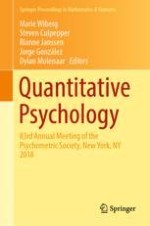2019 | OriginalPaper | Chapter
Additive Trees for Fitting Three-Way (Multiple Source) Proximity Data
Authors : Hans-Friedrich Köhn, Justin L. Kern
Published in: Quantitative Psychology
Publisher: Springer International Publishing
Activate our intelligent search to find suitable subject content or patents.
Select sections of text to find matching patents with Artificial Intelligence. powered by
Select sections of text to find additional relevant content using AI-assisted search. powered by
